Critical Care Nursing: Comprehensive Case Study on Cushing's Syndrome
VerifiedAdded on 2021/04/24
|9
|2568
|69
Case Study
AI Summary
This case study focuses on Susan Summers, a 40-year-old woman diagnosed with Cushing's syndrome due to a benign adrenal tumor, who underwent a laparoscopic right adrenalectomy. The essay delves into the causes and pathophysiology of Cushing's syndrome, emphasizing the role of excessive cortisol levels and potential contributing factors such as stress and alcoholism. The study analyzes Susan's post-operative condition, including hypothermia, tachycardia, and oliguria, explaining the underlying pathophysiology of these complications. It highlights the importance of appropriate nursing interventions, such as monitoring vital signs, maintaining fluid and electrolyte balance, and preventing complications, using the ISBAR and ABCDE approaches. The case study also underscores the significance of a multidisciplinary healthcare team, including social workers, counselors, and diabetes educators, for comprehensive patient care and discharge planning to ensure optimal recovery and prevent long-term complications. The assignment provides a detailed analysis of the patient's condition and recommended nursing interventions.
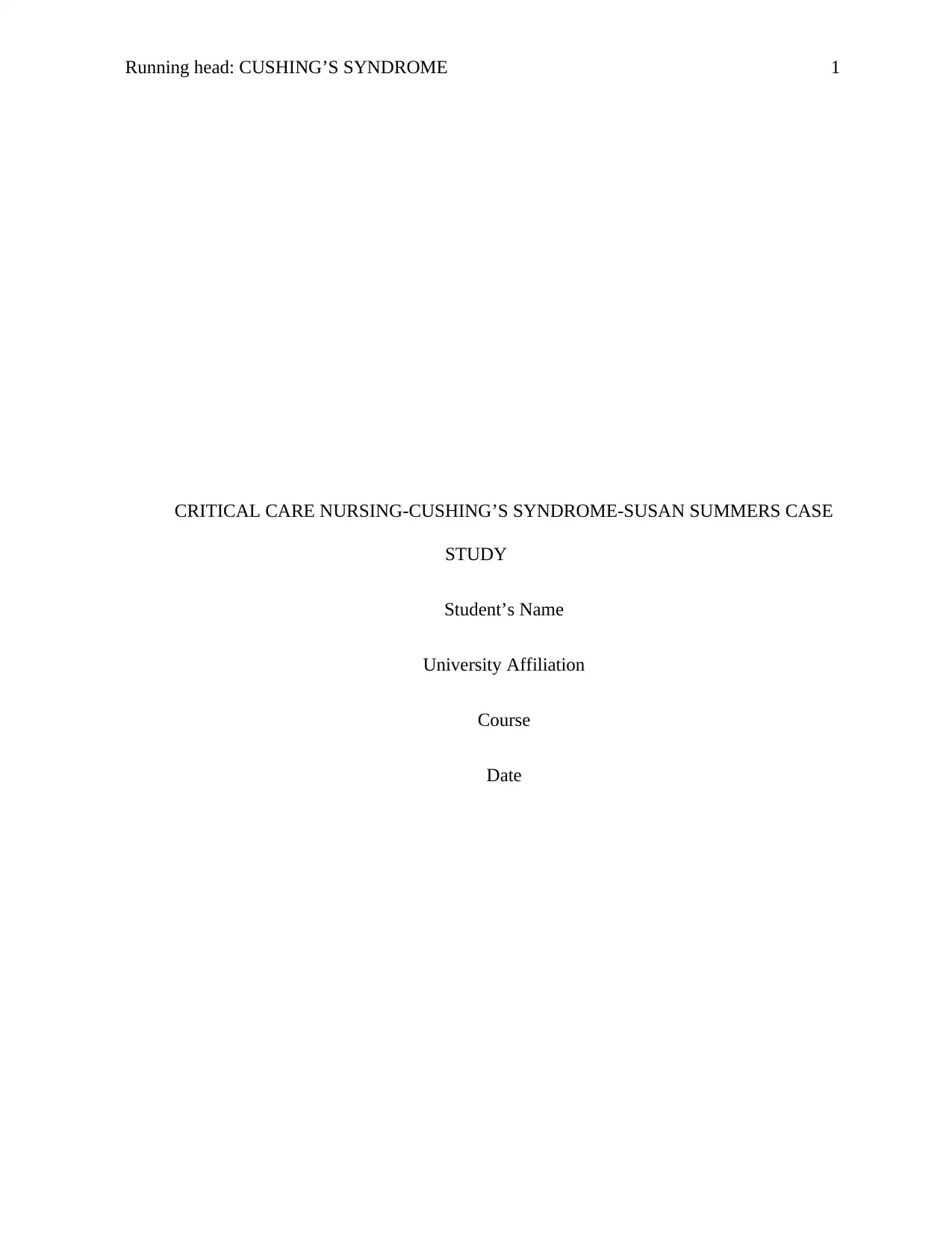
Running head: CUSHING’S SYNDROME 1
CRITICAL CARE NURSING-CUSHING’S SYNDROME-SUSAN SUMMERS CASE
STUDY
Student’s Name
University Affiliation
Course
Date
CRITICAL CARE NURSING-CUSHING’S SYNDROME-SUSAN SUMMERS CASE
STUDY
Student’s Name
University Affiliation
Course
Date
Paraphrase This Document
Need a fresh take? Get an instant paraphrase of this document with our AI Paraphraser
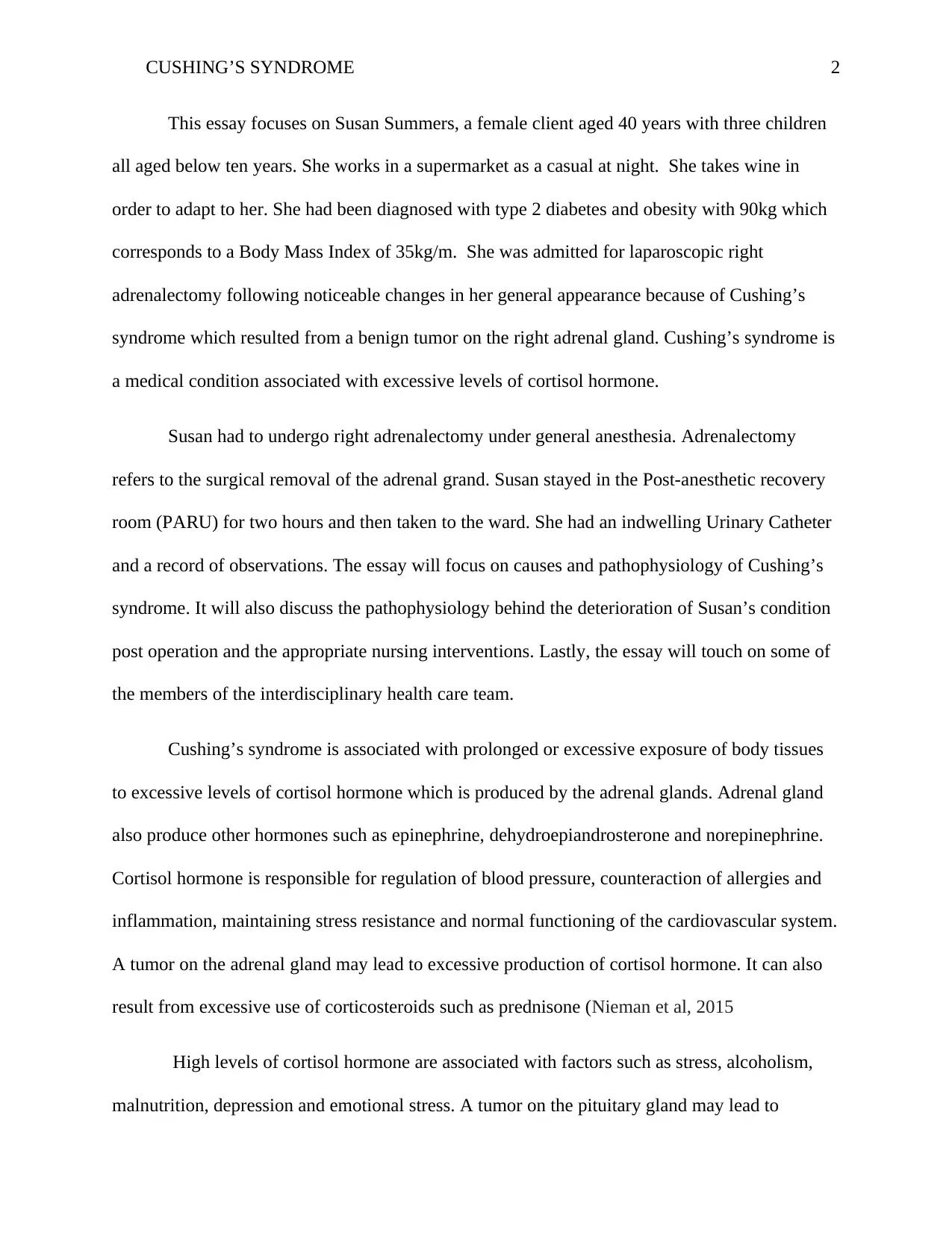
CUSHING’S SYNDROME 2
This essay focuses on Susan Summers, a female client aged 40 years with three children
all aged below ten years. She works in a supermarket as a casual at night. She takes wine in
order to adapt to her. She had been diagnosed with type 2 diabetes and obesity with 90kg which
corresponds to a Body Mass Index of 35kg/m. She was admitted for laparoscopic right
adrenalectomy following noticeable changes in her general appearance because of Cushing’s
syndrome which resulted from a benign tumor on the right adrenal gland. Cushing’s syndrome is
a medical condition associated with excessive levels of cortisol hormone.
Susan had to undergo right adrenalectomy under general anesthesia. Adrenalectomy
refers to the surgical removal of the adrenal grand. Susan stayed in the Post-anesthetic recovery
room (PARU) for two hours and then taken to the ward. She had an indwelling Urinary Catheter
and a record of observations. The essay will focus on causes and pathophysiology of Cushing’s
syndrome. It will also discuss the pathophysiology behind the deterioration of Susan’s condition
post operation and the appropriate nursing interventions. Lastly, the essay will touch on some of
the members of the interdisciplinary health care team.
Cushing’s syndrome is associated with prolonged or excessive exposure of body tissues
to excessive levels of cortisol hormone which is produced by the adrenal glands. Adrenal gland
also produce other hormones such as epinephrine, dehydroepiandrosterone and norepinephrine.
Cortisol hormone is responsible for regulation of blood pressure, counteraction of allergies and
inflammation, maintaining stress resistance and normal functioning of the cardiovascular system.
A tumor on the adrenal gland may lead to excessive production of cortisol hormone. It can also
result from excessive use of corticosteroids such as prednisone (Nieman et al, 2015
High levels of cortisol hormone are associated with factors such as stress, alcoholism,
malnutrition, depression and emotional stress. A tumor on the pituitary gland may lead to
This essay focuses on Susan Summers, a female client aged 40 years with three children
all aged below ten years. She works in a supermarket as a casual at night. She takes wine in
order to adapt to her. She had been diagnosed with type 2 diabetes and obesity with 90kg which
corresponds to a Body Mass Index of 35kg/m. She was admitted for laparoscopic right
adrenalectomy following noticeable changes in her general appearance because of Cushing’s
syndrome which resulted from a benign tumor on the right adrenal gland. Cushing’s syndrome is
a medical condition associated with excessive levels of cortisol hormone.
Susan had to undergo right adrenalectomy under general anesthesia. Adrenalectomy
refers to the surgical removal of the adrenal grand. Susan stayed in the Post-anesthetic recovery
room (PARU) for two hours and then taken to the ward. She had an indwelling Urinary Catheter
and a record of observations. The essay will focus on causes and pathophysiology of Cushing’s
syndrome. It will also discuss the pathophysiology behind the deterioration of Susan’s condition
post operation and the appropriate nursing interventions. Lastly, the essay will touch on some of
the members of the interdisciplinary health care team.
Cushing’s syndrome is associated with prolonged or excessive exposure of body tissues
to excessive levels of cortisol hormone which is produced by the adrenal glands. Adrenal gland
also produce other hormones such as epinephrine, dehydroepiandrosterone and norepinephrine.
Cortisol hormone is responsible for regulation of blood pressure, counteraction of allergies and
inflammation, maintaining stress resistance and normal functioning of the cardiovascular system.
A tumor on the adrenal gland may lead to excessive production of cortisol hormone. It can also
result from excessive use of corticosteroids such as prednisone (Nieman et al, 2015
High levels of cortisol hormone are associated with factors such as stress, alcoholism,
malnutrition, depression and emotional stress. A tumor on the pituitary gland may lead to
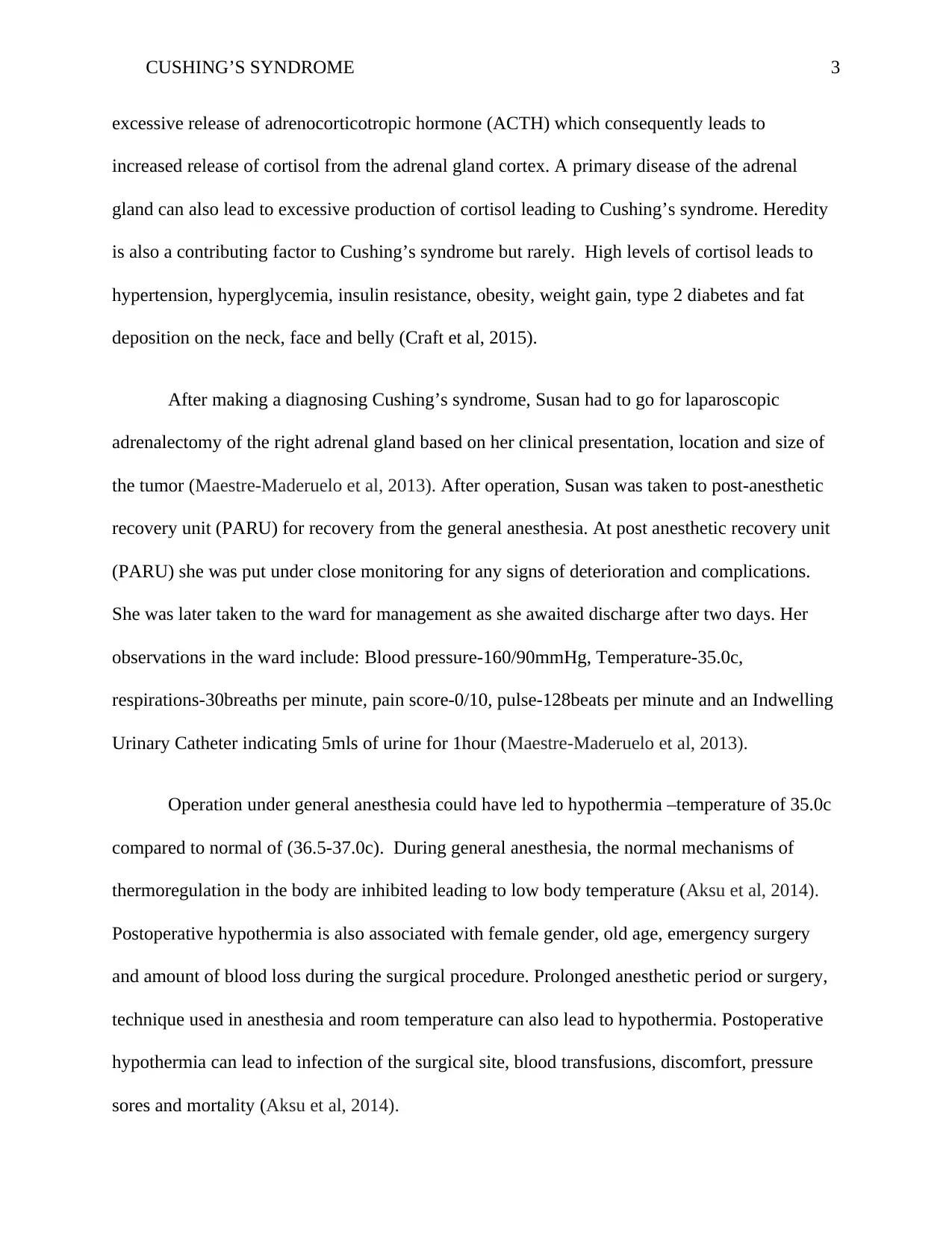
CUSHING’S SYNDROME 3
excessive release of adrenocorticotropic hormone (ACTH) which consequently leads to
increased release of cortisol from the adrenal gland cortex. A primary disease of the adrenal
gland can also lead to excessive production of cortisol leading to Cushing’s syndrome. Heredity
is also a contributing factor to Cushing’s syndrome but rarely. High levels of cortisol leads to
hypertension, hyperglycemia, insulin resistance, obesity, weight gain, type 2 diabetes and fat
deposition on the neck, face and belly (Craft et al, 2015).
After making a diagnosing Cushing’s syndrome, Susan had to go for laparoscopic
adrenalectomy of the right adrenal gland based on her clinical presentation, location and size of
the tumor (Maestre-Maderuelo et al, 2013). After operation, Susan was taken to post-anesthetic
recovery unit (PARU) for recovery from the general anesthesia. At post anesthetic recovery unit
(PARU) she was put under close monitoring for any signs of deterioration and complications.
She was later taken to the ward for management as she awaited discharge after two days. Her
observations in the ward include: Blood pressure-160/90mmHg, Temperature-35.0c,
respirations-30breaths per minute, pain score-0/10, pulse-128beats per minute and an Indwelling
Urinary Catheter indicating 5mls of urine for 1hour (Maestre-Maderuelo et al, 2013).
Operation under general anesthesia could have led to hypothermia –temperature of 35.0c
compared to normal of (36.5-37.0c). During general anesthesia, the normal mechanisms of
thermoregulation in the body are inhibited leading to low body temperature (Aksu et al, 2014).
Postoperative hypothermia is also associated with female gender, old age, emergency surgery
and amount of blood loss during the surgical procedure. Prolonged anesthetic period or surgery,
technique used in anesthesia and room temperature can also lead to hypothermia. Postoperative
hypothermia can lead to infection of the surgical site, blood transfusions, discomfort, pressure
sores and mortality (Aksu et al, 2014).
excessive release of adrenocorticotropic hormone (ACTH) which consequently leads to
increased release of cortisol from the adrenal gland cortex. A primary disease of the adrenal
gland can also lead to excessive production of cortisol leading to Cushing’s syndrome. Heredity
is also a contributing factor to Cushing’s syndrome but rarely. High levels of cortisol leads to
hypertension, hyperglycemia, insulin resistance, obesity, weight gain, type 2 diabetes and fat
deposition on the neck, face and belly (Craft et al, 2015).
After making a diagnosing Cushing’s syndrome, Susan had to go for laparoscopic
adrenalectomy of the right adrenal gland based on her clinical presentation, location and size of
the tumor (Maestre-Maderuelo et al, 2013). After operation, Susan was taken to post-anesthetic
recovery unit (PARU) for recovery from the general anesthesia. At post anesthetic recovery unit
(PARU) she was put under close monitoring for any signs of deterioration and complications.
She was later taken to the ward for management as she awaited discharge after two days. Her
observations in the ward include: Blood pressure-160/90mmHg, Temperature-35.0c,
respirations-30breaths per minute, pain score-0/10, pulse-128beats per minute and an Indwelling
Urinary Catheter indicating 5mls of urine for 1hour (Maestre-Maderuelo et al, 2013).
Operation under general anesthesia could have led to hypothermia –temperature of 35.0c
compared to normal of (36.5-37.0c). During general anesthesia, the normal mechanisms of
thermoregulation in the body are inhibited leading to low body temperature (Aksu et al, 2014).
Postoperative hypothermia is also associated with female gender, old age, emergency surgery
and amount of blood loss during the surgical procedure. Prolonged anesthetic period or surgery,
technique used in anesthesia and room temperature can also lead to hypothermia. Postoperative
hypothermia can lead to infection of the surgical site, blood transfusions, discomfort, pressure
sores and mortality (Aksu et al, 2014).
⊘ This is a preview!⊘
Do you want full access?
Subscribe today to unlock all pages.

Trusted by 1+ million students worldwide
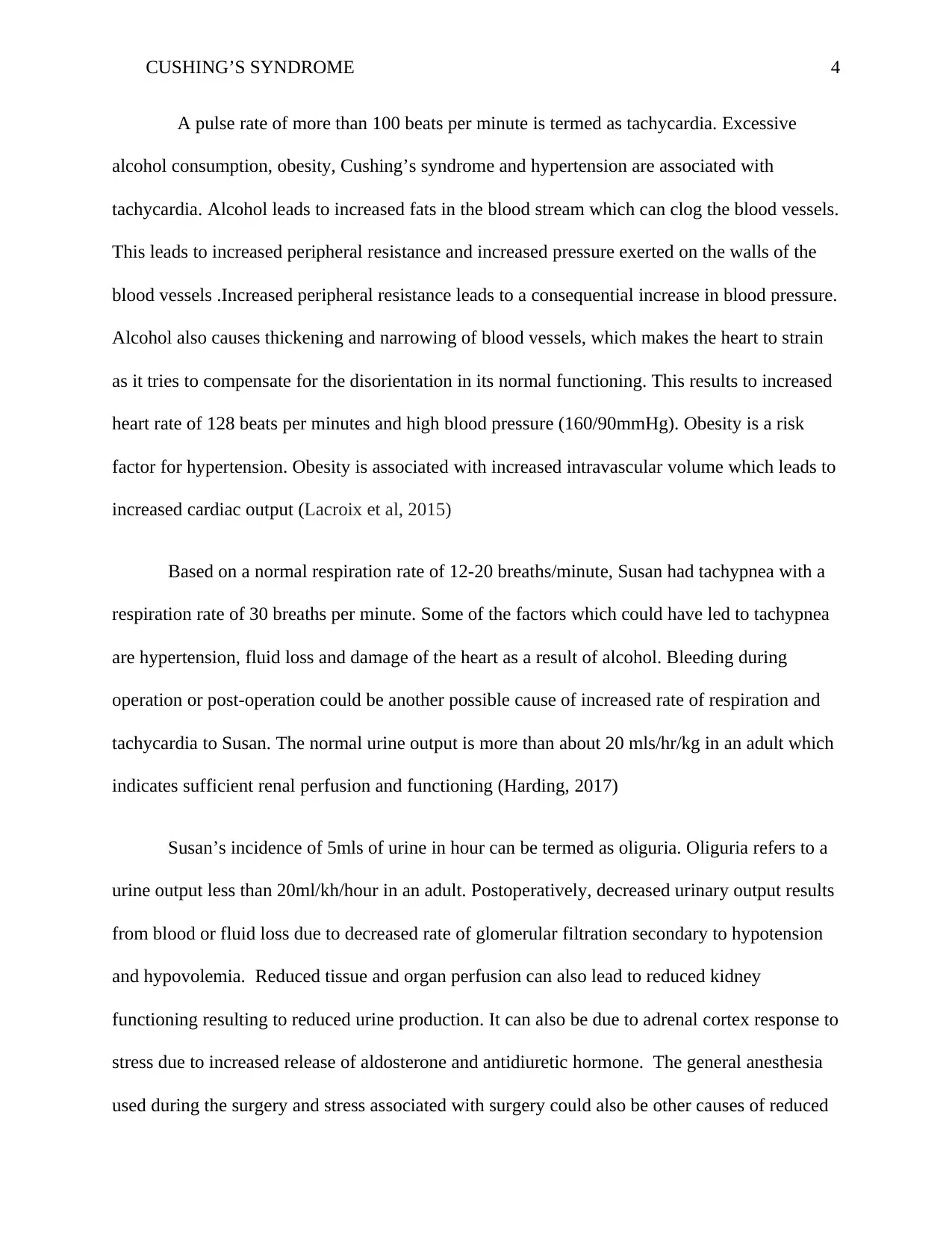
CUSHING’S SYNDROME 4
A pulse rate of more than 100 beats per minute is termed as tachycardia. Excessive
alcohol consumption, obesity, Cushing’s syndrome and hypertension are associated with
tachycardia. Alcohol leads to increased fats in the blood stream which can clog the blood vessels.
This leads to increased peripheral resistance and increased pressure exerted on the walls of the
blood vessels .Increased peripheral resistance leads to a consequential increase in blood pressure.
Alcohol also causes thickening and narrowing of blood vessels, which makes the heart to strain
as it tries to compensate for the disorientation in its normal functioning. This results to increased
heart rate of 128 beats per minutes and high blood pressure (160/90mmHg). Obesity is a risk
factor for hypertension. Obesity is associated with increased intravascular volume which leads to
increased cardiac output (Lacroix et al, 2015)
Based on a normal respiration rate of 12-20 breaths/minute, Susan had tachypnea with a
respiration rate of 30 breaths per minute. Some of the factors which could have led to tachypnea
are hypertension, fluid loss and damage of the heart as a result of alcohol. Bleeding during
operation or post-operation could be another possible cause of increased rate of respiration and
tachycardia to Susan. The normal urine output is more than about 20 mls/hr/kg in an adult which
indicates sufficient renal perfusion and functioning (Harding, 2017)
Susan’s incidence of 5mls of urine in hour can be termed as oliguria. Oliguria refers to a
urine output less than 20ml/kh/hour in an adult. Postoperatively, decreased urinary output results
from blood or fluid loss due to decreased rate of glomerular filtration secondary to hypotension
and hypovolemia. Reduced tissue and organ perfusion can also lead to reduced kidney
functioning resulting to reduced urine production. It can also be due to adrenal cortex response to
stress due to increased release of aldosterone and antidiuretic hormone. The general anesthesia
used during the surgery and stress associated with surgery could also be other causes of reduced
A pulse rate of more than 100 beats per minute is termed as tachycardia. Excessive
alcohol consumption, obesity, Cushing’s syndrome and hypertension are associated with
tachycardia. Alcohol leads to increased fats in the blood stream which can clog the blood vessels.
This leads to increased peripheral resistance and increased pressure exerted on the walls of the
blood vessels .Increased peripheral resistance leads to a consequential increase in blood pressure.
Alcohol also causes thickening and narrowing of blood vessels, which makes the heart to strain
as it tries to compensate for the disorientation in its normal functioning. This results to increased
heart rate of 128 beats per minutes and high blood pressure (160/90mmHg). Obesity is a risk
factor for hypertension. Obesity is associated with increased intravascular volume which leads to
increased cardiac output (Lacroix et al, 2015)
Based on a normal respiration rate of 12-20 breaths/minute, Susan had tachypnea with a
respiration rate of 30 breaths per minute. Some of the factors which could have led to tachypnea
are hypertension, fluid loss and damage of the heart as a result of alcohol. Bleeding during
operation or post-operation could be another possible cause of increased rate of respiration and
tachycardia to Susan. The normal urine output is more than about 20 mls/hr/kg in an adult which
indicates sufficient renal perfusion and functioning (Harding, 2017)
Susan’s incidence of 5mls of urine in hour can be termed as oliguria. Oliguria refers to a
urine output less than 20ml/kh/hour in an adult. Postoperatively, decreased urinary output results
from blood or fluid loss due to decreased rate of glomerular filtration secondary to hypotension
and hypovolemia. Reduced tissue and organ perfusion can also lead to reduced kidney
functioning resulting to reduced urine production. It can also be due to adrenal cortex response to
stress due to increased release of aldosterone and antidiuretic hormone. The general anesthesia
used during the surgery and stress associated with surgery could also be other causes of reduced
Paraphrase This Document
Need a fresh take? Get an instant paraphrase of this document with our AI Paraphraser
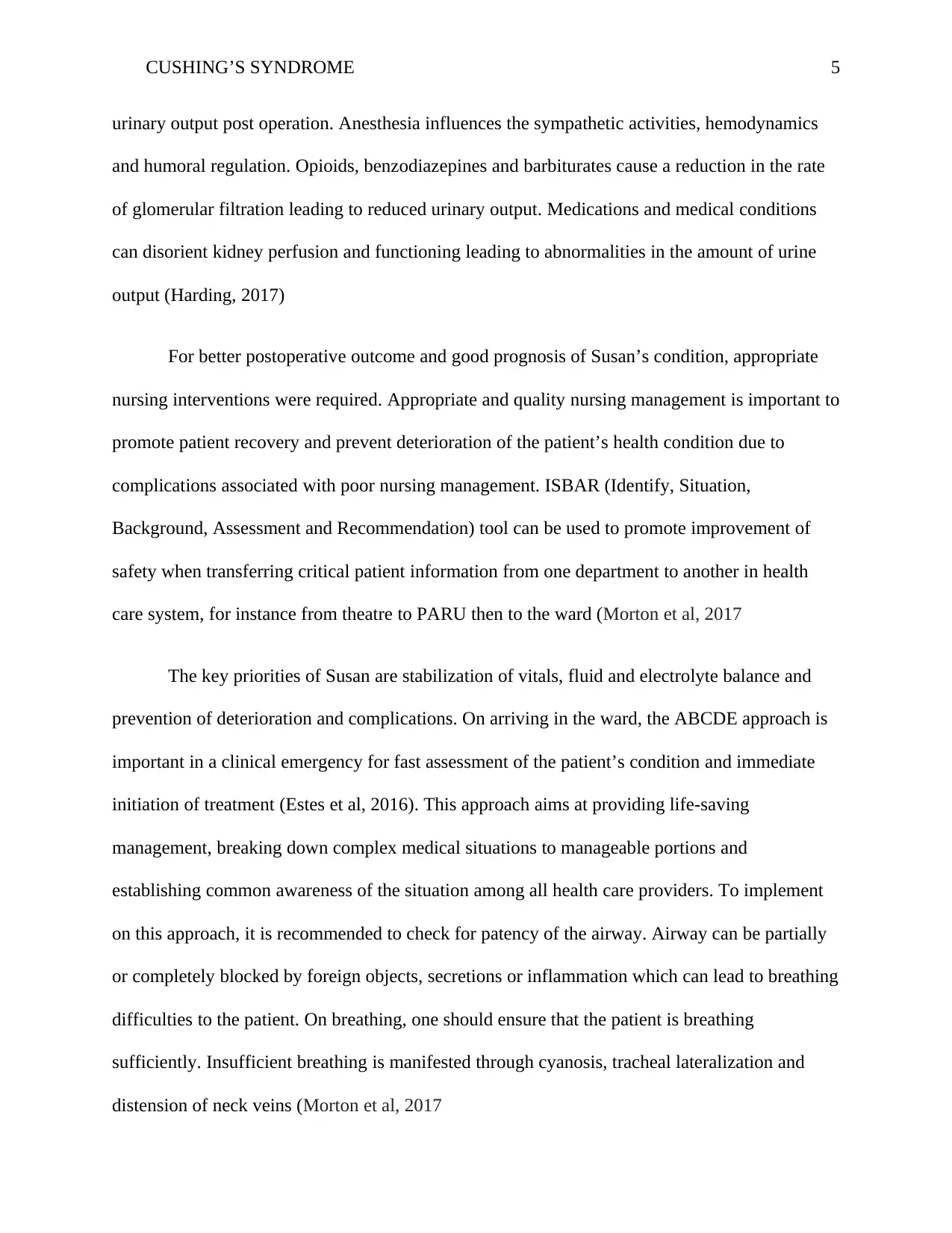
CUSHING’S SYNDROME 5
urinary output post operation. Anesthesia influences the sympathetic activities, hemodynamics
and humoral regulation. Opioids, benzodiazepines and barbiturates cause a reduction in the rate
of glomerular filtration leading to reduced urinary output. Medications and medical conditions
can disorient kidney perfusion and functioning leading to abnormalities in the amount of urine
output (Harding, 2017)
For better postoperative outcome and good prognosis of Susan’s condition, appropriate
nursing interventions were required. Appropriate and quality nursing management is important to
promote patient recovery and prevent deterioration of the patient’s health condition due to
complications associated with poor nursing management. ISBAR (Identify, Situation,
Background, Assessment and Recommendation) tool can be used to promote improvement of
safety when transferring critical patient information from one department to another in health
care system, for instance from theatre to PARU then to the ward (Morton et al, 2017
The key priorities of Susan are stabilization of vitals, fluid and electrolyte balance and
prevention of deterioration and complications. On arriving in the ward, the ABCDE approach is
important in a clinical emergency for fast assessment of the patient’s condition and immediate
initiation of treatment (Estes et al, 2016). This approach aims at providing life-saving
management, breaking down complex medical situations to manageable portions and
establishing common awareness of the situation among all health care providers. To implement
on this approach, it is recommended to check for patency of the airway. Airway can be partially
or completely blocked by foreign objects, secretions or inflammation which can lead to breathing
difficulties to the patient. On breathing, one should ensure that the patient is breathing
sufficiently. Insufficient breathing is manifested through cyanosis, tracheal lateralization and
distension of neck veins (Morton et al, 2017
urinary output post operation. Anesthesia influences the sympathetic activities, hemodynamics
and humoral regulation. Opioids, benzodiazepines and barbiturates cause a reduction in the rate
of glomerular filtration leading to reduced urinary output. Medications and medical conditions
can disorient kidney perfusion and functioning leading to abnormalities in the amount of urine
output (Harding, 2017)
For better postoperative outcome and good prognosis of Susan’s condition, appropriate
nursing interventions were required. Appropriate and quality nursing management is important to
promote patient recovery and prevent deterioration of the patient’s health condition due to
complications associated with poor nursing management. ISBAR (Identify, Situation,
Background, Assessment and Recommendation) tool can be used to promote improvement of
safety when transferring critical patient information from one department to another in health
care system, for instance from theatre to PARU then to the ward (Morton et al, 2017
The key priorities of Susan are stabilization of vitals, fluid and electrolyte balance and
prevention of deterioration and complications. On arriving in the ward, the ABCDE approach is
important in a clinical emergency for fast assessment of the patient’s condition and immediate
initiation of treatment (Estes et al, 2016). This approach aims at providing life-saving
management, breaking down complex medical situations to manageable portions and
establishing common awareness of the situation among all health care providers. To implement
on this approach, it is recommended to check for patency of the airway. Airway can be partially
or completely blocked by foreign objects, secretions or inflammation which can lead to breathing
difficulties to the patient. On breathing, one should ensure that the patient is breathing
sufficiently. Insufficient breathing is manifested through cyanosis, tracheal lateralization and
distension of neck veins (Morton et al, 2017
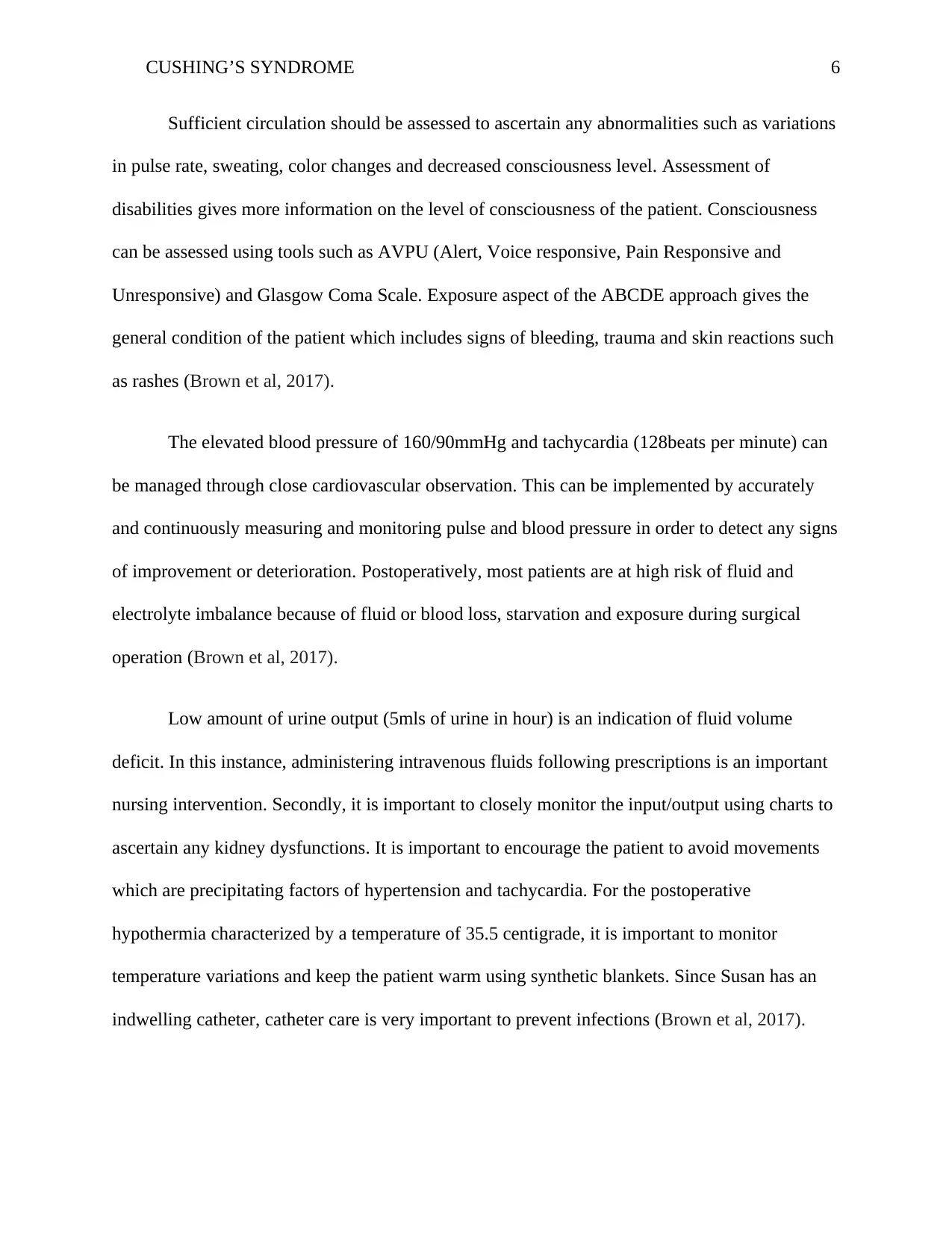
CUSHING’S SYNDROME 6
Sufficient circulation should be assessed to ascertain any abnormalities such as variations
in pulse rate, sweating, color changes and decreased consciousness level. Assessment of
disabilities gives more information on the level of consciousness of the patient. Consciousness
can be assessed using tools such as AVPU (Alert, Voice responsive, Pain Responsive and
Unresponsive) and Glasgow Coma Scale. Exposure aspect of the ABCDE approach gives the
general condition of the patient which includes signs of bleeding, trauma and skin reactions such
as rashes (Brown et al, 2017).
The elevated blood pressure of 160/90mmHg and tachycardia (128beats per minute) can
be managed through close cardiovascular observation. This can be implemented by accurately
and continuously measuring and monitoring pulse and blood pressure in order to detect any signs
of improvement or deterioration. Postoperatively, most patients are at high risk of fluid and
electrolyte imbalance because of fluid or blood loss, starvation and exposure during surgical
operation (Brown et al, 2017).
Low amount of urine output (5mls of urine in hour) is an indication of fluid volume
deficit. In this instance, administering intravenous fluids following prescriptions is an important
nursing intervention. Secondly, it is important to closely monitor the input/output using charts to
ascertain any kidney dysfunctions. It is important to encourage the patient to avoid movements
which are precipitating factors of hypertension and tachycardia. For the postoperative
hypothermia characterized by a temperature of 35.5 centigrade, it is important to monitor
temperature variations and keep the patient warm using synthetic blankets. Since Susan has an
indwelling catheter, catheter care is very important to prevent infections (Brown et al, 2017).
Sufficient circulation should be assessed to ascertain any abnormalities such as variations
in pulse rate, sweating, color changes and decreased consciousness level. Assessment of
disabilities gives more information on the level of consciousness of the patient. Consciousness
can be assessed using tools such as AVPU (Alert, Voice responsive, Pain Responsive and
Unresponsive) and Glasgow Coma Scale. Exposure aspect of the ABCDE approach gives the
general condition of the patient which includes signs of bleeding, trauma and skin reactions such
as rashes (Brown et al, 2017).
The elevated blood pressure of 160/90mmHg and tachycardia (128beats per minute) can
be managed through close cardiovascular observation. This can be implemented by accurately
and continuously measuring and monitoring pulse and blood pressure in order to detect any signs
of improvement or deterioration. Postoperatively, most patients are at high risk of fluid and
electrolyte imbalance because of fluid or blood loss, starvation and exposure during surgical
operation (Brown et al, 2017).
Low amount of urine output (5mls of urine in hour) is an indication of fluid volume
deficit. In this instance, administering intravenous fluids following prescriptions is an important
nursing intervention. Secondly, it is important to closely monitor the input/output using charts to
ascertain any kidney dysfunctions. It is important to encourage the patient to avoid movements
which are precipitating factors of hypertension and tachycardia. For the postoperative
hypothermia characterized by a temperature of 35.5 centigrade, it is important to monitor
temperature variations and keep the patient warm using synthetic blankets. Since Susan has an
indwelling catheter, catheter care is very important to prevent infections (Brown et al, 2017).
⊘ This is a preview!⊘
Do you want full access?
Subscribe today to unlock all pages.

Trusted by 1+ million students worldwide
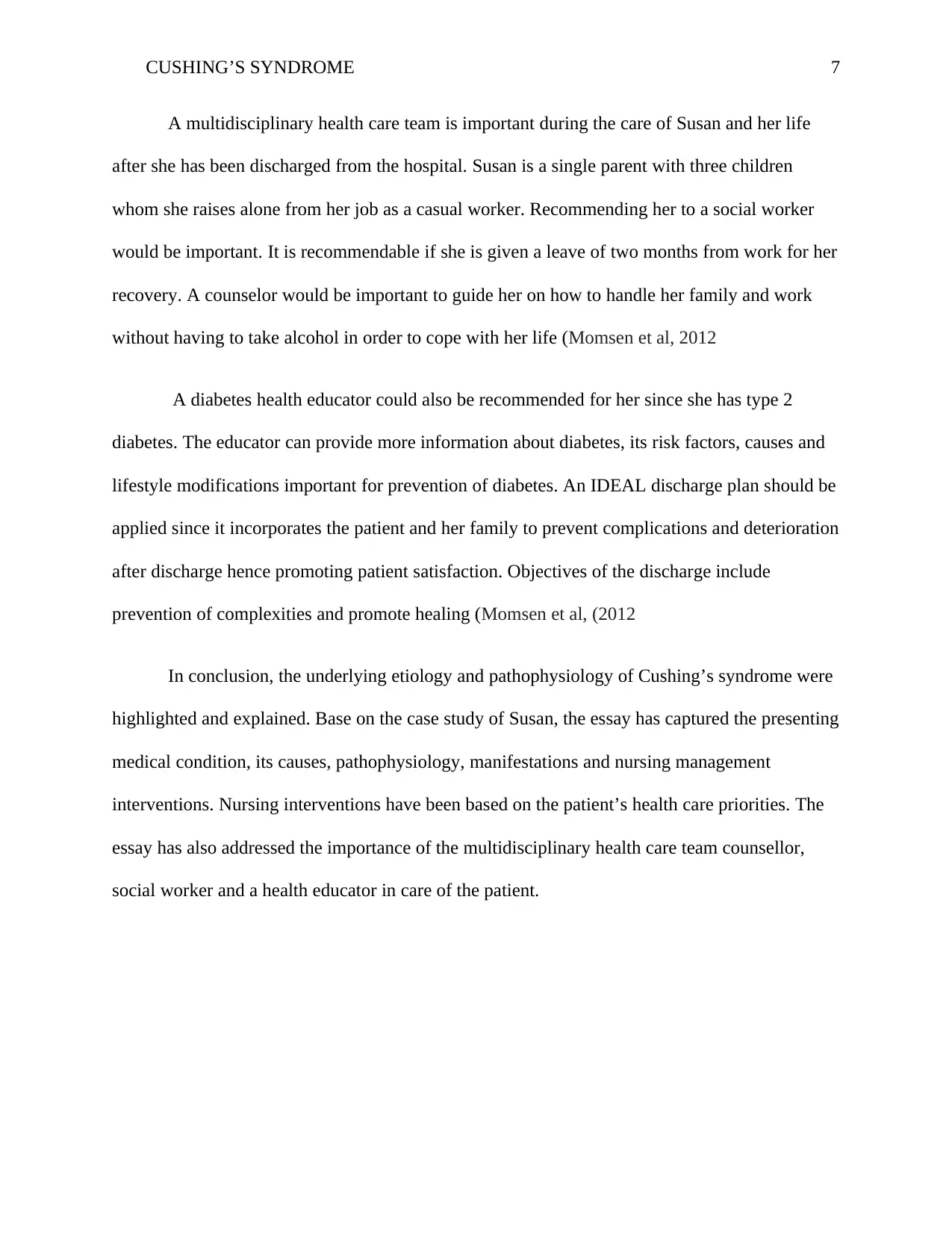
CUSHING’S SYNDROME 7
A multidisciplinary health care team is important during the care of Susan and her life
after she has been discharged from the hospital. Susan is a single parent with three children
whom she raises alone from her job as a casual worker. Recommending her to a social worker
would be important. It is recommendable if she is given a leave of two months from work for her
recovery. A counselor would be important to guide her on how to handle her family and work
without having to take alcohol in order to cope with her life (Momsen et al, 2012
A diabetes health educator could also be recommended for her since she has type 2
diabetes. The educator can provide more information about diabetes, its risk factors, causes and
lifestyle modifications important for prevention of diabetes. An IDEAL discharge plan should be
applied since it incorporates the patient and her family to prevent complications and deterioration
after discharge hence promoting patient satisfaction. Objectives of the discharge include
prevention of complexities and promote healing (Momsen et al, (2012
In conclusion, the underlying etiology and pathophysiology of Cushing’s syndrome were
highlighted and explained. Base on the case study of Susan, the essay has captured the presenting
medical condition, its causes, pathophysiology, manifestations and nursing management
interventions. Nursing interventions have been based on the patient’s health care priorities. The
essay has also addressed the importance of the multidisciplinary health care team counsellor,
social worker and a health educator in care of the patient.
A multidisciplinary health care team is important during the care of Susan and her life
after she has been discharged from the hospital. Susan is a single parent with three children
whom she raises alone from her job as a casual worker. Recommending her to a social worker
would be important. It is recommendable if she is given a leave of two months from work for her
recovery. A counselor would be important to guide her on how to handle her family and work
without having to take alcohol in order to cope with her life (Momsen et al, 2012
A diabetes health educator could also be recommended for her since she has type 2
diabetes. The educator can provide more information about diabetes, its risk factors, causes and
lifestyle modifications important for prevention of diabetes. An IDEAL discharge plan should be
applied since it incorporates the patient and her family to prevent complications and deterioration
after discharge hence promoting patient satisfaction. Objectives of the discharge include
prevention of complexities and promote healing (Momsen et al, (2012
In conclusion, the underlying etiology and pathophysiology of Cushing’s syndrome were
highlighted and explained. Base on the case study of Susan, the essay has captured the presenting
medical condition, its causes, pathophysiology, manifestations and nursing management
interventions. Nursing interventions have been based on the patient’s health care priorities. The
essay has also addressed the importance of the multidisciplinary health care team counsellor,
social worker and a health educator in care of the patient.
Paraphrase This Document
Need a fresh take? Get an instant paraphrase of this document with our AI Paraphraser
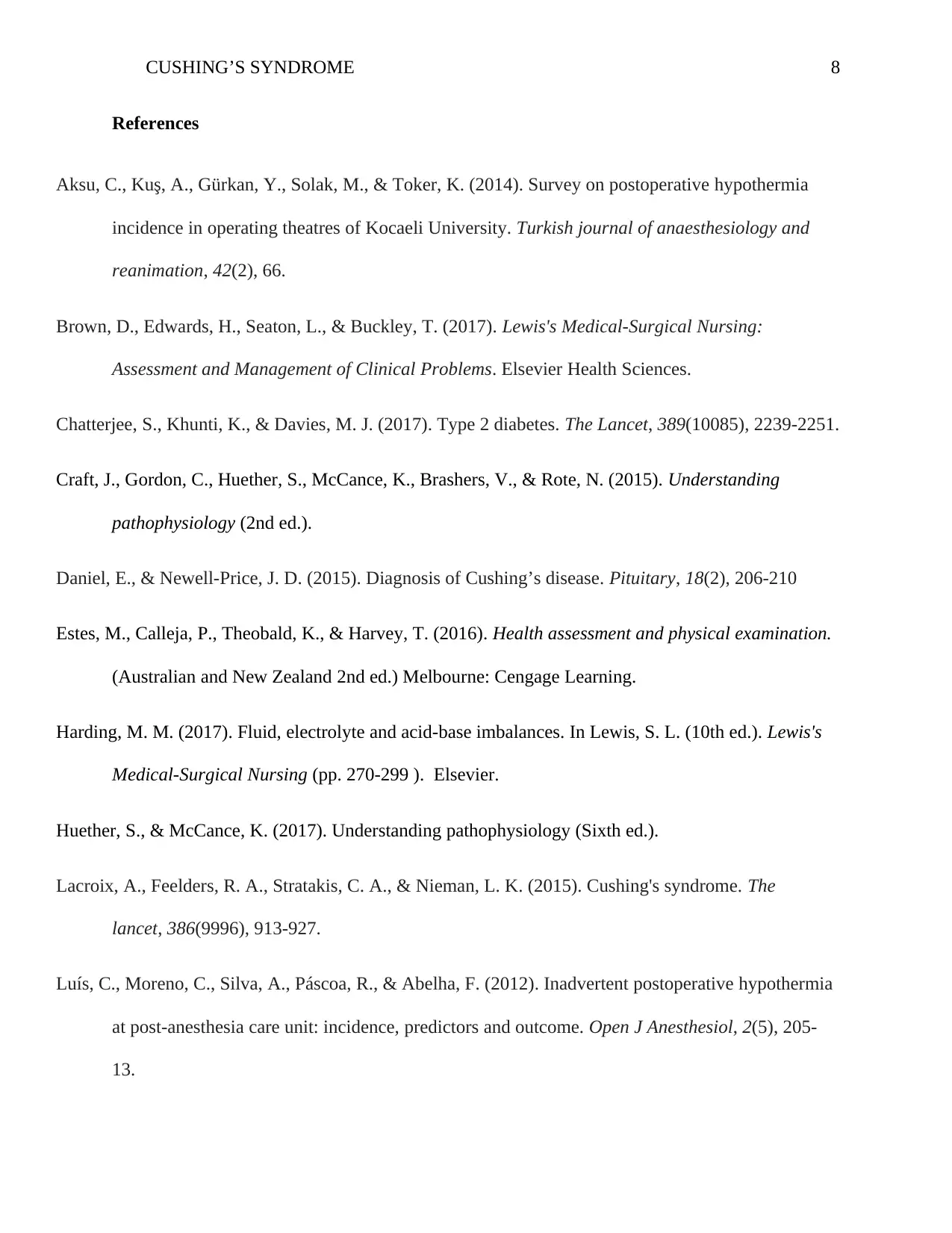
CUSHING’S SYNDROME 8
References
Aksu, C., Kuş, A., Gürkan, Y., Solak, M., & Toker, K. (2014). Survey on postoperative hypothermia
incidence in operating theatres of Kocaeli University. Turkish journal of anaesthesiology and
reanimation, 42(2), 66.
Brown, D., Edwards, H., Seaton, L., & Buckley, T. (2017). Lewis's Medical-Surgical Nursing:
Assessment and Management of Clinical Problems. Elsevier Health Sciences.
Chatterjee, S., Khunti, K., & Davies, M. J. (2017). Type 2 diabetes. The Lancet, 389(10085), 2239-2251.
Craft, J., Gordon, C., Huether, S., McCance, K., Brashers, V., & Rote, N. (2015). Understanding
pathophysiology (2nd ed.).
Daniel, E., & Newell-Price, J. D. (2015). Diagnosis of Cushing’s disease. Pituitary, 18(2), 206-210
Estes, M., Calleja, P., Theobald, K., & Harvey, T. (2016). Health assessment and physical examination.
(Australian and New Zealand 2nd ed.) Melbourne: Cengage Learning.
Harding, M. M. (2017). Fluid, electrolyte and acid-base imbalances. In Lewis, S. L. (10th ed.). Lewis's
Medical-Surgical Nursing (pp. 270-299 ). Elsevier.
Huether, S., & McCance, K. (2017). Understanding pathophysiology (Sixth ed.).
Lacroix, A., Feelders, R. A., Stratakis, C. A., & Nieman, L. K. (2015). Cushing's syndrome. The
lancet, 386(9996), 913-927.
Luís, C., Moreno, C., Silva, A., Páscoa, R., & Abelha, F. (2012). Inadvertent postoperative hypothermia
at post-anesthesia care unit: incidence, predictors and outcome. Open J Anesthesiol, 2(5), 205-
13.
References
Aksu, C., Kuş, A., Gürkan, Y., Solak, M., & Toker, K. (2014). Survey on postoperative hypothermia
incidence in operating theatres of Kocaeli University. Turkish journal of anaesthesiology and
reanimation, 42(2), 66.
Brown, D., Edwards, H., Seaton, L., & Buckley, T. (2017). Lewis's Medical-Surgical Nursing:
Assessment and Management of Clinical Problems. Elsevier Health Sciences.
Chatterjee, S., Khunti, K., & Davies, M. J. (2017). Type 2 diabetes. The Lancet, 389(10085), 2239-2251.
Craft, J., Gordon, C., Huether, S., McCance, K., Brashers, V., & Rote, N. (2015). Understanding
pathophysiology (2nd ed.).
Daniel, E., & Newell-Price, J. D. (2015). Diagnosis of Cushing’s disease. Pituitary, 18(2), 206-210
Estes, M., Calleja, P., Theobald, K., & Harvey, T. (2016). Health assessment and physical examination.
(Australian and New Zealand 2nd ed.) Melbourne: Cengage Learning.
Harding, M. M. (2017). Fluid, electrolyte and acid-base imbalances. In Lewis, S. L. (10th ed.). Lewis's
Medical-Surgical Nursing (pp. 270-299 ). Elsevier.
Huether, S., & McCance, K. (2017). Understanding pathophysiology (Sixth ed.).
Lacroix, A., Feelders, R. A., Stratakis, C. A., & Nieman, L. K. (2015). Cushing's syndrome. The
lancet, 386(9996), 913-927.
Luís, C., Moreno, C., Silva, A., Páscoa, R., & Abelha, F. (2012). Inadvertent postoperative hypothermia
at post-anesthesia care unit: incidence, predictors and outcome. Open J Anesthesiol, 2(5), 205-
13.
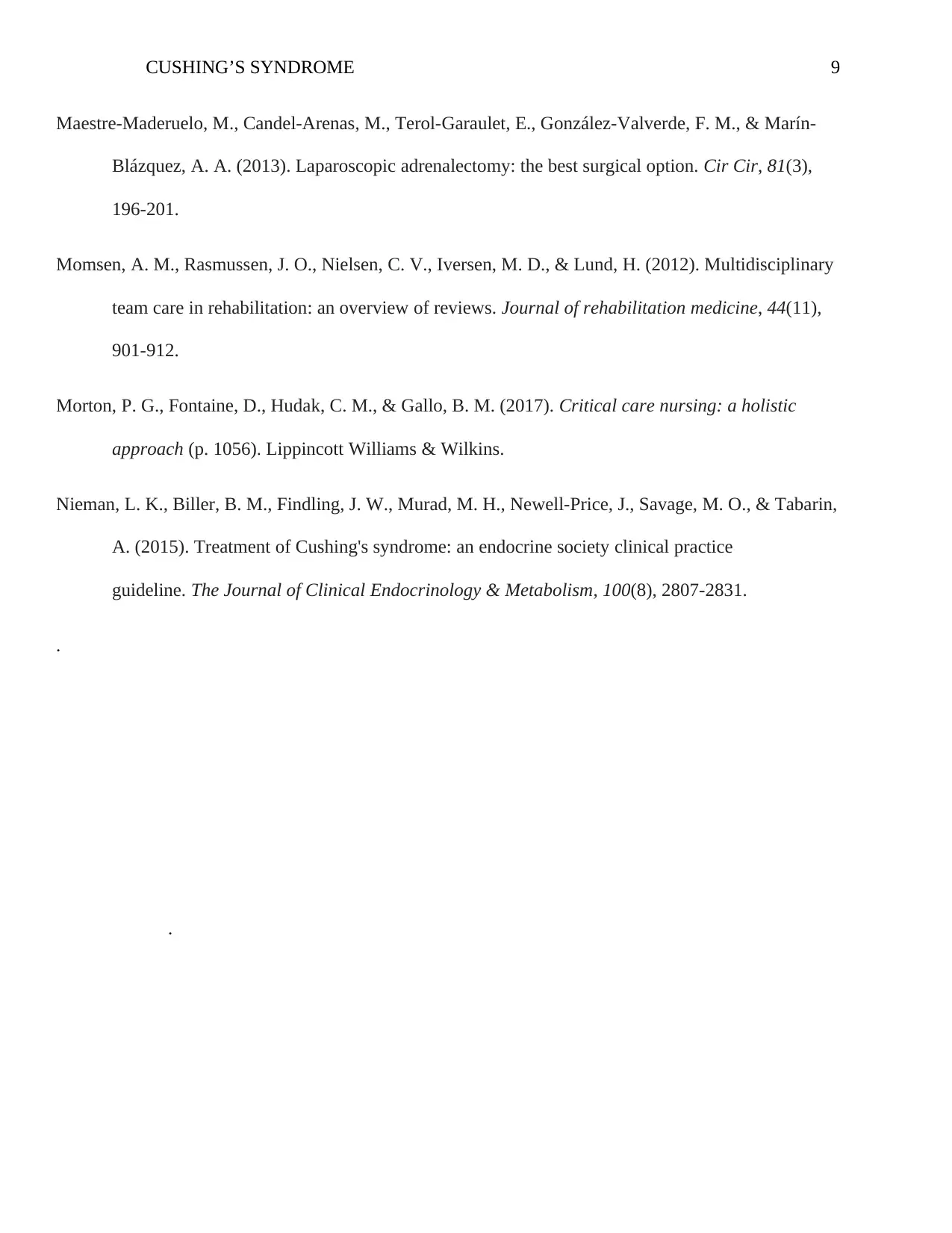
CUSHING’S SYNDROME 9
Maestre-Maderuelo, M., Candel-Arenas, M., Terol-Garaulet, E., González-Valverde, F. M., & Marín-
Blázquez, A. A. (2013). Laparoscopic adrenalectomy: the best surgical option. Cir Cir, 81(3),
196-201.
Momsen, A. M., Rasmussen, J. O., Nielsen, C. V., Iversen, M. D., & Lund, H. (2012). Multidisciplinary
team care in rehabilitation: an overview of reviews. Journal of rehabilitation medicine, 44(11),
901-912.
Morton, P. G., Fontaine, D., Hudak, C. M., & Gallo, B. M. (2017). Critical care nursing: a holistic
approach (p. 1056). Lippincott Williams & Wilkins.
Nieman, L. K., Biller, B. M., Findling, J. W., Murad, M. H., Newell-Price, J., Savage, M. O., & Tabarin,
A. (2015). Treatment of Cushing's syndrome: an endocrine society clinical practice
guideline. The Journal of Clinical Endocrinology & Metabolism, 100(8), 2807-2831.
.
.
Maestre-Maderuelo, M., Candel-Arenas, M., Terol-Garaulet, E., González-Valverde, F. M., & Marín-
Blázquez, A. A. (2013). Laparoscopic adrenalectomy: the best surgical option. Cir Cir, 81(3),
196-201.
Momsen, A. M., Rasmussen, J. O., Nielsen, C. V., Iversen, M. D., & Lund, H. (2012). Multidisciplinary
team care in rehabilitation: an overview of reviews. Journal of rehabilitation medicine, 44(11),
901-912.
Morton, P. G., Fontaine, D., Hudak, C. M., & Gallo, B. M. (2017). Critical care nursing: a holistic
approach (p. 1056). Lippincott Williams & Wilkins.
Nieman, L. K., Biller, B. M., Findling, J. W., Murad, M. H., Newell-Price, J., Savage, M. O., & Tabarin,
A. (2015). Treatment of Cushing's syndrome: an endocrine society clinical practice
guideline. The Journal of Clinical Endocrinology & Metabolism, 100(8), 2807-2831.
.
.
⊘ This is a preview!⊘
Do you want full access?
Subscribe today to unlock all pages.

Trusted by 1+ million students worldwide
1 out of 9
Related Documents
Your All-in-One AI-Powered Toolkit for Academic Success.
+13062052269
info@desklib.com
Available 24*7 on WhatsApp / Email
![[object Object]](/_next/static/media/star-bottom.7253800d.svg)
Unlock your academic potential
Copyright © 2020–2025 A2Z Services. All Rights Reserved. Developed and managed by ZUCOL.





